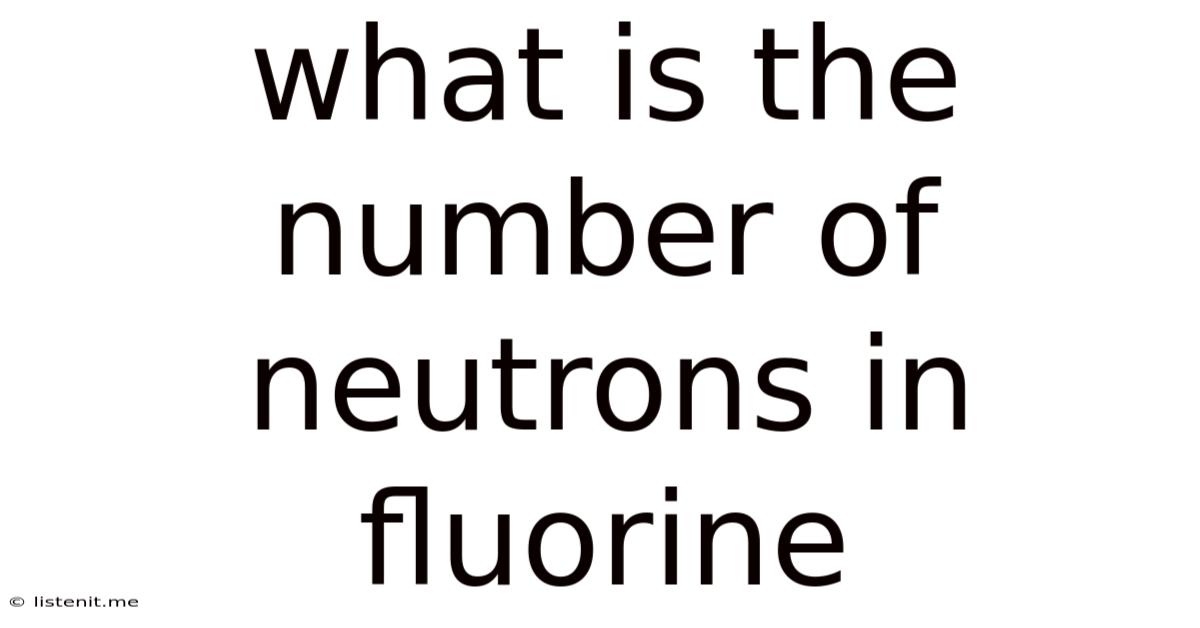What Is The Number Of Neutrons In Fluorine
listenit
May 13, 2025 · 4 min read

Table of Contents
What is the Number of Neutrons in Fluorine? A Deep Dive into Isotopes and Nuclear Structure
Fluorine, a highly reactive nonmetal element crucial in various applications, presents a fascinating case study in nuclear structure. Understanding the number of neutrons in fluorine requires delving into the concept of isotopes and exploring the atomic structure of this element. This comprehensive guide will unravel the mysteries of fluorine's neutrons, explaining the underlying principles and providing detailed information for both beginners and advanced learners.
Understanding Atomic Structure: Protons, Neutrons, and Electrons
Before we dive into the specifics of fluorine's neutrons, let's revisit the fundamental building blocks of an atom:
- Protons: Positively charged particles located in the atom's nucleus. The number of protons defines the element; all fluorine atoms have 9 protons.
- Neutrons: Neutral particles (no charge) also residing in the nucleus. The number of neutrons can vary within the same element, leading to isotopes.
- Electrons: Negatively charged particles orbiting the nucleus in electron shells. The number of electrons typically equals the number of protons in a neutral atom.
Isotopes: The Key to Varying Neutron Numbers
The key to understanding the variable number of neutrons in fluorine lies in the concept of isotopes. Isotopes are atoms of the same element (same number of protons) but with a different number of neutrons. This difference in neutron number affects the atom's mass but not its chemical properties significantly. Most elements exist as a mixture of isotopes.
Fluorine's Main Isotope: Fluorine-19
Fluorine primarily exists as a single stable isotope: Fluorine-19 (¹⁹F). The number after the element's name represents the mass number (A), which is the sum of protons and neutrons. Since fluorine always has 9 protons, we can calculate the number of neutrons in Fluorine-19:
Mass number (A) = Number of protons + Number of neutrons
19 = 9 + Number of neutrons
Number of neutrons = 10
Therefore, Fluorine-19 has 10 neutrons. This is the most abundant and stable isotope of fluorine, making up nearly 100% of naturally occurring fluorine.
Other Fluorine Isotopes: Radioactive and Unstable
While Fluorine-19 is the dominant form, other fluorine isotopes exist, all of which are radioactive and unstable. These isotopes decay over time, transforming into other elements through processes like beta decay or alpha decay. These radioactive isotopes have shorter lifespans and are not naturally occurring in significant amounts. Some examples include:
- Fluorine-17 (¹⁷F): This isotope has 8 neutrons (17 - 9 = 8). It's radioactive and decays through positron emission and electron capture.
- Fluorine-18 (¹⁸F): Possessing 9 neutrons (18 - 9 = 9), this isotope is also radioactive and is used extensively in Positron Emission Tomography (PET) scans in medical imaging due to its relatively short half-life.
- Fluorine-20 (²⁰F): With 11 neutrons (20 - 9 = 11), it's a highly radioactive isotope with a very short half-life.
Understanding Half-Life
The half-life of a radioactive isotope is the time it takes for half of the atoms in a sample to decay. Different fluorine isotopes have vastly different half-lives, ranging from fractions of a second to several hours. This characteristic is crucial in applications like medical imaging where the short half-life of ¹⁸F ensures minimal radiation exposure to patients.
The Significance of Neutron Number
The number of neutrons in an atom's nucleus plays a significant role in several aspects:
-
Nuclear Stability: The neutron-to-proton ratio is a critical factor determining an atom's stability. For lighter elements, a ratio close to 1:1 tends to be stable. However, as atomic number increases, more neutrons are needed to maintain stability due to the increasing strength of the electrostatic repulsion between protons. The instability of fluorine isotopes other than ¹⁹F exemplifies this principle.
-
Nuclear Reactions: The number of neutrons influences how an atom participates in nuclear reactions, including fission and fusion. Radioactive isotopes like ¹⁸F are used in various nuclear processes.
-
Mass and Density: Neutrons contribute significantly to an atom's mass, directly influencing the element's physical properties such as density.
Fluorine's Role in Various Applications
Fluorine, particularly its stable isotope ¹⁹F, is crucial in a wide range of applications:
- Fluoride in Toothpaste: Fluoride ions help strengthen tooth enamel, preventing cavities.
- Teflon (Polytetrafluoroethylene): This non-stick coating utilizes fluorine's unique properties for its durability and inertness.
- Refrigerants: Certain fluorocarbons were used as refrigerants, although their environmental impact has led to the development of more sustainable alternatives.
- Nuclear Medicine: The radioactive isotope ¹⁸F plays a vital role in PET scans, assisting in the diagnosis and monitoring of various diseases.
Conclusion: A Deeper Understanding of Fluorine's Neutrons
In conclusion, understanding the number of neutrons in fluorine requires an understanding of isotopes and nuclear structure. While the most common and stable isotope, ¹⁹F, contains 10 neutrons, other radioactive isotopes exist with varying neutron numbers. These isotopes, while less abundant, hold significant importance in various applications, especially in nuclear medicine. The number of neutrons fundamentally impacts an atom's stability, reactivity, and overall properties, making it a critical aspect of nuclear science and its numerous applications. Further research into the behavior of fluorine isotopes continues to expand our understanding of atomic structure and nuclear processes.
Latest Posts
Latest Posts
-
Graph Y 3 1 2 X 2
May 13, 2025
-
What Fraction Is Equivalent To 0 6 Repeating
May 13, 2025
-
Is Pressure Directly Proportional To Temperature
May 13, 2025
-
Approximately What Basic Composition Are All Stars Born With
May 13, 2025
-
How Do You Write 2 9 As A Decimal
May 13, 2025
Related Post
Thank you for visiting our website which covers about What Is The Number Of Neutrons In Fluorine . We hope the information provided has been useful to you. Feel free to contact us if you have any questions or need further assistance. See you next time and don't miss to bookmark.